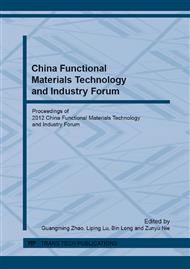p.7
p.11
p.15
p.19
p.25
p.30
p.35
p.40
p.44
Study on the Preparation and Micro-Structural Characterization of SiC Nanowires Obtained by Direct Microwave Heating
Abstract:
SiC nanowires have been synthesized by microwave-vacuum heating method at 1480°C, using silicon powders, silica dioxide powders and artificial graphite as raw materials. SEM, TEM and XRD were employed to investigate the micro-structure of obtained specimens. It was shown that β-SiC can be directly synthesized directly without any catalyst on the basis of the vapor-solid (VS) growth mechanism. The obtained specimens exhibited various morphologies and sizes, due to the differences in the reaction temperatures and the distribution of components in the crucible. Products existed in upper crucible were bright-green and more pure, mainly consisting of nanorods with a diameter of about 150nm and some SiC micro-crystals. At the same time, the surface oxidation phenomenon was not obvious. As to the grey-green products existed in other zone, lots of SiC/SiO2 coaxial nanowires with a diameter around 20-50 nm (the thickness of SiO2 surface layer was about 2nm) were successfully obtained. Besides, there also remained some un-reacted graphite and silica dioxide. The excitation light with wavelength of 240nm was used to test the photoluminescence properties of the products. Results showed that both of the SiC nanorods and SiC/SiO2 coaxial nanowires exhibited a strong broad photoluminescence peak at wavelength of about 390nm, displaying a higher degree of blue-shift in comparison to the reported luminescence results of β-SiC nanomaterials.
Info:
Periodical:
Pages:
25-29
Citation:
Online since:
May 2013
Authors:
Price:
Сopyright:
© 2013 Trans Tech Publications Ltd. All Rights Reserved
Share:
Citation:


